Chuang Ming-tseng (莊明增) recalls carrying oil bamboo torches up Siuluan Mountain (秀巒山) and forming “fire dragons” with his classmates as a child. But the chief of Hsinchu County’s Beipu Township (北埔) only learned the true significance of this unique Lantern Festival ritual a few years ago.
“We just thought it was fun,” he tells the Taipei Times. “Locals just knew to go up there during this time … Over time, many forgot why this custom existed.”
With the event gaining popularity in recent years — last month’s event attracted more than 3,000 participants, forming one continuous fire dragon — the township office needed to provide a coherent narrative to the spectacle. Elders can still remember that it was originally to repair Beipu’s severed “dragon vein” (龍脈), referring to mountain ridges that carry auspicious energy from a “dragon lair” (龍穴, or meridian spot) to the town.
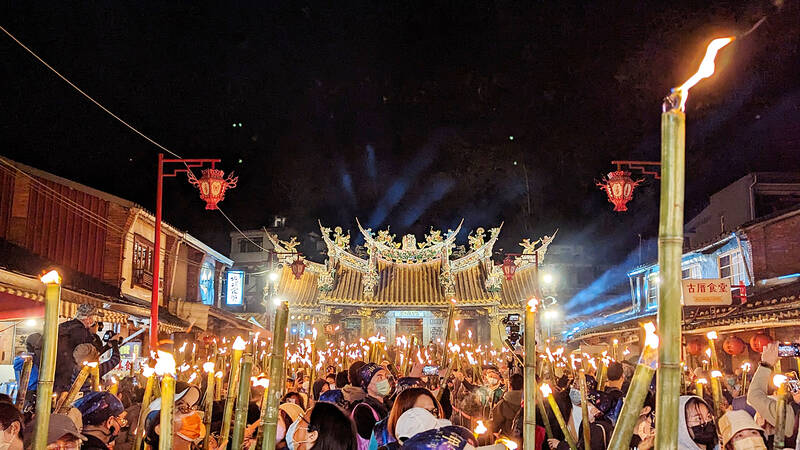
Photo: Han Cheung, Taipei Times
“Prosperity can come through a dragon vein in many forms, including wealth, a flourishing population or a successful career in politics,” Citien Temple (慈天宮) director Chiang Jui-chin (姜瑞金) says.
Chiang adds that the original temple was built on the vein in the 1830s, and the current settlement formed around it.
Through field research, organizers concluded that Japanese colonizers had cut the vein by building a straight road between the temple and the mountain to suppress the fortunes of the influential Chiang (姜) family. Chiang Jui-chin says this act led to the decline of Beipu — and many sons in the Chiang clan to die young. After the Japanese defeat in 1945, a geomancer instructed the townspeople to walk up the mountain in a queue holding torches on the 15th day of the Lunar New Year to rejuvenate the town, and the practice has continued ever since.
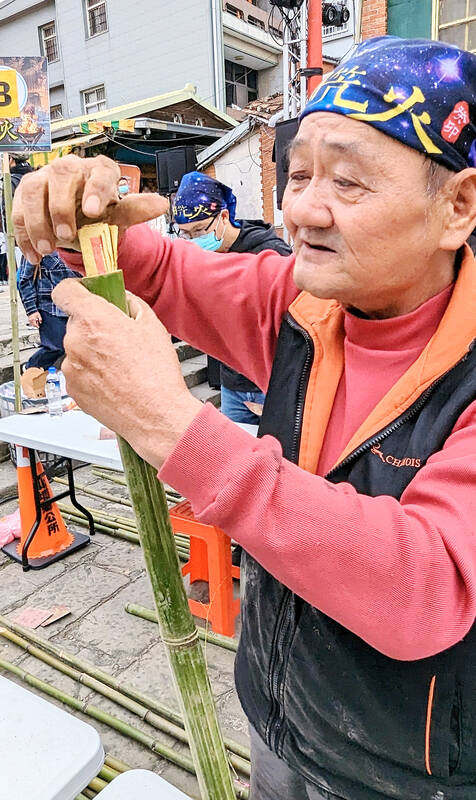
Photo: Han Cheung, Taipei Times
“Fire is considered prosperous, so it’s able to reconnect the vein,” Chiang says. “But back then, 50 or 60 years ago, we weren’t trying to form dragons, we were just having fun running all over the hills with our torches. Since there were no tall buildings then, you could see from afar little fire dragons zipping all over the mountain.”
SLEEPING TIGER
There were just a few fireworks set off on Saturday before the crowd traveled up the hill, but no firecrackers could be heard. That’s because this particular dragon lair is shaped like a sleeping tiger and must not be disturbed, Chiang says.
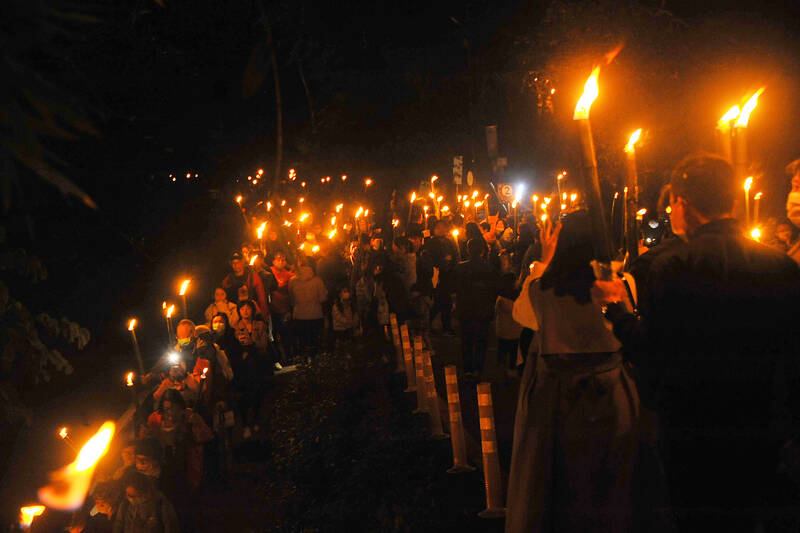
Photo: Han Cheung, Taipei Times
Chiang says that during the Lunar New Year in 1907, the Chiang family broke the taboo by holding a raucous celebration in front of the temple. That November, the Beipu Uprising against the Japanese broke out, and eventually the rebels fled into the surrounding mountains. The Japanese troops threatened to slaughter the entire town’s inhabitants if they couldn’t catch the insurgents, and it cost the Chiangs and other local elites a lot of money and pleading to prevent a massacre.
“That’s why the stage is always down the road when we hold major religious events,” Chiang says. “That way, the gods can see it, but the tiger can’t hear it.”
When asked if the thousands of people walking up the mountain would disturb the tiger, Chiang replies: “[They] aren’t loud enough.”
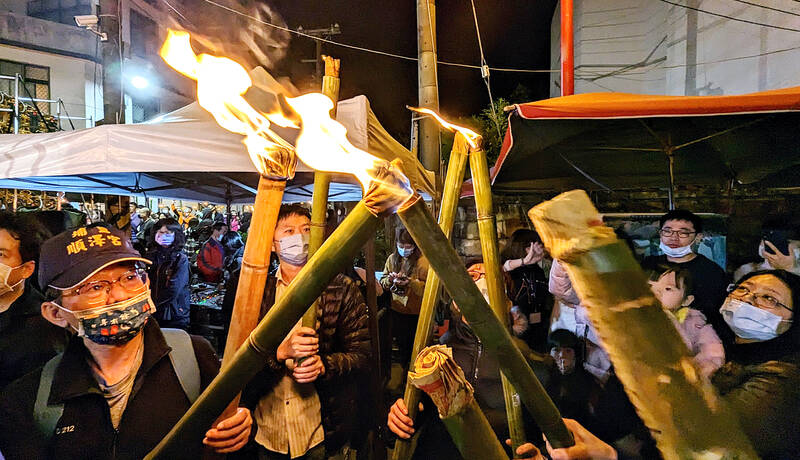
Photo: Han Cheung, Taipei Times
The bamboo torch festival has become increasingly well-organized and attended since the Beipu Township Office took over in 2019. Tourists now sign up weeks in advance, and volunteers on site help enthusiastic visitors construct the torch, which is made by pouring oil into the bamboo’s center and stuffing the top with a roll of spirit paper.
Television host Hsu Tzu-yen (徐子雁), a mainstay at festivals in this area, is animatedly providing over-the-top commentary and directing the crowd, while modern fire dancers strut their stuff on stage.
The whole temple plaza is lit up, and a temple official carries the “mother flame” to the main stage where local leaders — including Chuang — ignite their torches. The fire is then passed through the crowd, torch-to-torch, until a mosaic of orange dots cover the entire area. Then they march, along with participants from nine surrounding villages, up a concrete footpath into the hills.
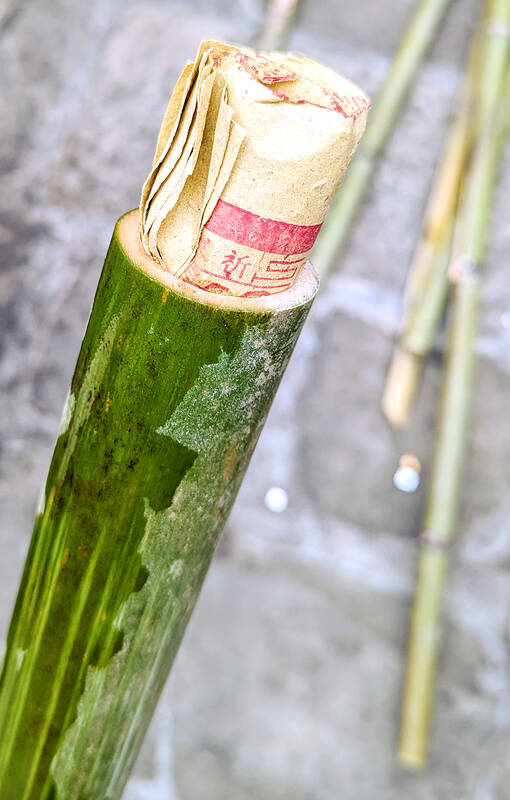
Photo: Han Cheung, Taipei Times
CHANGING TIMES
This spectacle didn’t exist when Chuang and Chiang were growing up, as organizations and families would head up on their own. Most families owned bamboo torches anyway, Chiang says, and it was mostly the boys who would carry them while the girls brought lanterns. At one point, adults placed treasures in the mountains for the children to hunt.
“What’s curious is that even though the town used to consist of mostly wooden buildings, there’s never been a fire due to this ritual as far as I can remember,” Chiang says.
Since the turn of the century, various groups in town, including the business association, have tried their hand at turning the practice into a local attraction. Chiang says they enjoyed considerable success in the early 2000s, but later stopped due to funding issues. Efforts restarted in the mid-2010s, and according to the Liberty Times (Taipei Times’ sister paper), the 2018 event attracted about 400 participants.
The “mother flame” part was devised in 2019 by the township office to create more of a sense of ceremony, Chuang says. Having the village leaders receive the flame on stage symbolizes the unity across the township, while passing it to tourists from the center to the periphery represents continuing the spirit of prosperity and the strength to protect one’s home and country, he says.
It’s not completely invented, Chuang says, as there used to be a continuously burning flame in the temple, but it was extinguished due to its designation as a historic building.
Chuang also provides evidence for the Japanese cutting the dragon vein: in addition to elders mentioning “repairing the vein,” he says the straight road behind the temple unnaturally cuts off a crucial part of its “dragon spirit.” There are many instances of people destroying dragon lairs or veins throughout history, and the Japanese had good reason to fear the Chiang family, especially since one member, Chiang Shao-tzu (姜紹祖), led a fierce resistance against their occupation in 1895.
“These stories were only passed down orally and there isn’t a complete record of it, but after organizing all the information we found, it makes a lot of sense,” Chuang says.

On April 26, The Lancet published a letter from two doctors at Taichung-based China Medical University Hospital (CMUH) warning that “Taiwan’s Health Care System is on the Brink of Collapse.” The authors said that “Years of policy inaction and mismanagement of resources have led to the National Health Insurance system operating under unsustainable conditions.” The pushback was immediate. Errors in the paper were quickly identified and publicized, to discredit the authors (the hospital apologized). CNA reported that CMUH said the letter described Taiwan in 2021 as having 62 nurses per 10,000 people, when the correct number was 78 nurses per 10,000

As we live longer, our risk of cognitive impairment is increasing. How can we delay the onset of symptoms? Do we have to give up every indulgence or can small changes make a difference? We asked neurologists for tips on how to keep our brains healthy for life. TAKE CARE OF YOUR HEALTH “All of the sensible things that apply to bodily health apply to brain health,” says Suzanne O’Sullivan, a consultant in neurology at the National Hospital for Neurology and Neurosurgery in London, and the author of The Age of Diagnosis. “When you’re 20, you can get away with absolute

May 5 to May 11 What started out as friction between Taiwanese students at Taichung First High School and a Japanese head cook escalated dramatically over the first two weeks of May 1927. It began on April 30 when the cook’s wife knew that lotus starch used in that night’s dinner had rat feces in it, but failed to inform staff until the meal was already prepared. The students believed that her silence was intentional, and filed a complaint. The school’s Japanese administrators sided with the cook’s family, dismissing the students as troublemakers and clamping down on their freedoms — with

As Donald Trump’s executive order in March led to the shuttering of Voice of America (VOA) — the global broadcaster whose roots date back to the fight against Nazi propaganda — he quickly attracted support from figures not used to aligning themselves with any US administration. Trump had ordered the US Agency for Global Media, the federal agency that funds VOA and other groups promoting independent journalism overseas, to be “eliminated to the maximum extent consistent with applicable law.” The decision suddenly halted programming in 49 languages to more than 425 million people. In Moscow, Margarita Simonyan, the hardline editor-in-chief of the